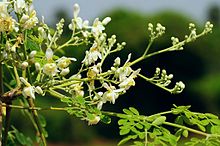Moringa oleifera
Moringa oleifera is the most widely cultivated species in the genus Moringa, the only genus in the plant family Moringaceae. Common names include moringa,[2] drumstick tree[2] (from the long, slender, triangular seed-pods), horseradish tree[2] (from the taste of the roots, which resembles horseradish), and ben oil tree or benzoil tree[2] (from the oil which is derived from the seeds).
M. oleifera is a fast-growing, drought-resistant tree, native to tropical and subtropical regions of South Asia.[3] It is widely cultivated for its young seed pods and leaves used as vegetables and for traditional herbal medicine. It is also used for water purification.[4][5] M. oleifera is considered to be an aggressive invasive species.[3]
Etymology
Description
M. oleifera is a fast-growing, deciduous tree[7] that can reach a height of 10–12 m (32–40 ft) and trunk diameter of 45 cm (1.5 ft).[8] The bark has a whitish-grey colour and is surrounded by thick cork. Young shoots have purplish or greenish-white, hairy bark. The tree has an open crown of drooping, fragile branches and the leaves build up a feathery foliage of tripinnate leaves.
The flowers are fragrant and asexual,[3]surrounded by five unequal, thinly veined, yellowish-white petals. The flowers are about 1.0–1.5 cm (1/2") long and 2.0 cm (3/4") broad. They grow on slender, hairy stalks in spreading or drooping flower clusters which have a length of 10–25 cm.[8]
Flowering begins within the first six months after planting. In seasonally cool regions, flowering only occurs once a year between April and June. In more constant seasonal temperatures and with constant rainfall, flowering can happen twice or even all year-round.[8]
The fruit is a hanging, three-sided brown capsule of 20–45 cm size which holds dark brown, globular seeds with a diameter around 1 cm. The seeds have three whitish papery wings and are dispersed by wind and water.[8]





No comments:
Post a Comment